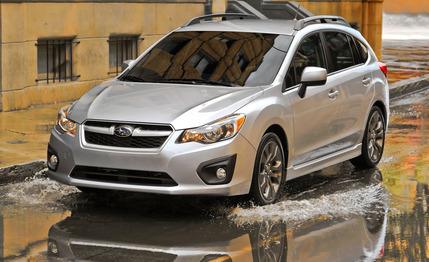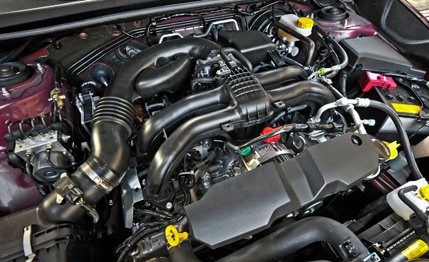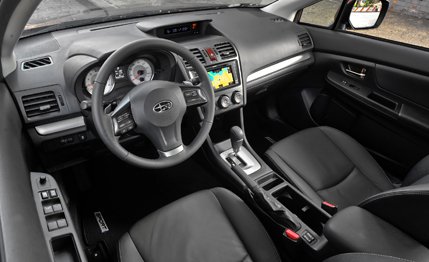
 Instrumented Test
Instrumented Test


In the sea of economy cars, the 2012 Subaru Impreza swims among some fairly appetizing competition. The new Impreza’s styling alone helps it stand out better among big fish—the Ford Focus, the Volkswagen Golf, the Honda Civic—than did its predecessor. But the previous car’s biggest handicap against its competition wasn’t its looks but its fuel economy; to that end, Subie has swapped the old four-speed automatic transmission for a more efficient continuously variable gearbox.
Exterior Attitude, Interior Blahs
But first, back to the styling. The 2012 Impreza fits right in at Subaru showrooms with its scaled-down Legacy looks. The sheetmetal even has a little bit of an attitude, although the same cannot be said for the interior, even if it is ergo-friendly. Inside, the materials are average and the overall design is stark and lacks any sort of personality. That’s a shame, really, because we love sitting in the comfy bucket seats, and back-seat passengers will appreciate the generous amounts of leg- and headroom. They won’t enjoy the copious wind and road noise. Compared with the previous car, overall passenger volume for the five-door increases by nearly three cubic feet; cargo volume (rear seats folded) gains an impressive eight cubes, for a total of 52.4. Have we mentioned lately how much we love the versatility of wagons and hatchbacks?
Out with the 2.5-liter, In with the 2.0
The engine compartment of the 2012 Impreza houses a new flat-four of smaller displacement than the outgoing car’s. Down by 0.5 liter to 2.0, it’s weaker than the old engine by 22 hp and 25 lb-ft of torque, for totals of 148 hp and 145 lb-ft. Subaru claims the new car’s slight weight reduction offsets any performance penalty from the lower-output motor. But as we discovered with a manual-equipped Impreza sedan we tested, that’s not quite the case—it was a second slower to 60 mph than the previous stick-shifted Impreza. Although we don’t have test figures for the previous Impreza 2.5 with its four-speed automatic, our 2.0-liter hatchback CVT test car took a leisurely nine seconds flat to hit 60 mph and 17 seconds to cover the quarter-mile at 83 mph. The new 2.0-liter with the CVT is now rated at a much improved 27 mpg city and 36 highway, up from the 20/26 assigned to the 2.5-liter car with the four-speed auto. Impressive on paper, but we saw only 22 mpg overall during our 600-mile test.


Unrefined Powertrain
From the first moment, the new boxer engine exhibited some of the NVH issues we associated with the old one. (This despite the inherent balance of flat engines.) The engine never feels completely smooth, but the roughness was exacerbated in the cold. We tested during a week where temperatures hovered around a chilly, but not extreme, 30 degrees Fahrenheit. On startup, the engine usually revved immediately to 2000 rpm and vibrated strongly enough to send tremors through the entire car for about 30 seconds, at which point it began to settle into a lower idle.
On one occasion, as we lifted off the brake after having shifted from park to drive, we experienced a startling clunk and a delay in forward progress. It was unsettling, but no more so than the constant, annoying droning caused by the CVT while under way. We were all for ditching the old-school four-speed auto but would prefer to see, say, a six-speed conventional automatic used here, EPA ratings be damned. We’ve been told, however, that Subaru is committed to the CVT; there’s yet another reason to Save the Manuals.
Powertrain issues aside, the Impreza is a decent drive. It has great outward visibility, commendable steering feedback, and a just-right suspension tune that nicely balances handling and ride. The brake pedal felt a little spongy in our test car, but the binders produced an excellent 70-to-0-mph stopping distance of 166 feet.


Much of the competition is quicker and more refined, but the Impreza keeps an edge by offering standard all-wheel drive, rare even as an option in this segment. Expect to pay about the same as for higher trims of competing vehicles, though, for the all-weather peace of mind. Our top-spec five-door Sport Limited CVT started at $23,345, with another $2000 tacked on for the sunroof-and-navigation package. For the same $25,345, one could easily drive away in a similarly equipped Legacy Premium sedan or, if a hatchback is a priority, the better-driving Ford Focus five-door or even the VW GTI. Given the plethora of more satisfying options both in the segment and for the money, we’d leave this particular fish in the water.